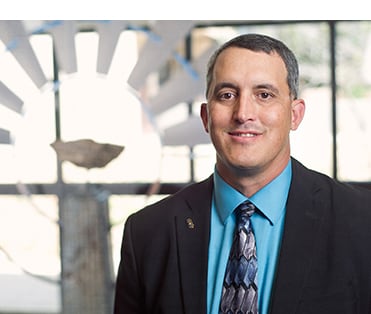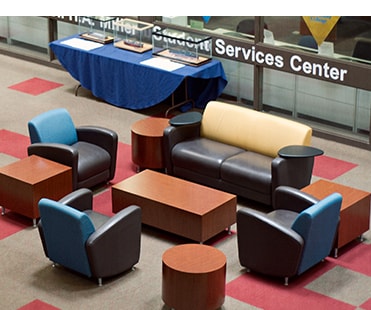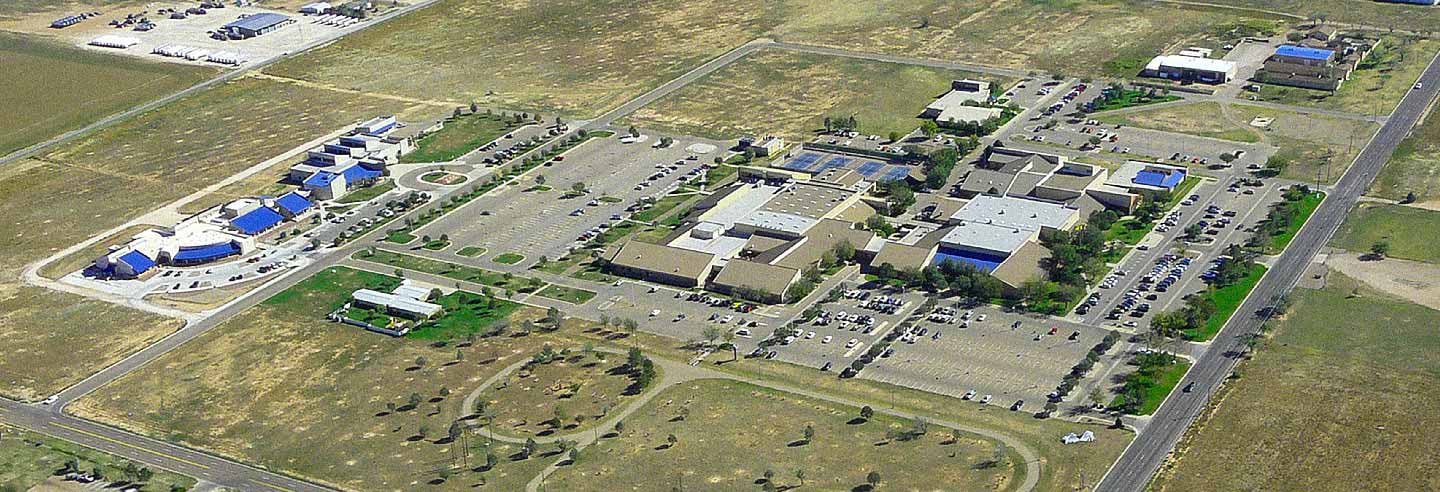Clovis Community College Learns to Think Inside the Box
A small IT staff aces data center modernization when it combines hyperconverged appliances and server virtualization, achieving cost savings and other efficiencies.
Clovis Community College’s Ricky Fuentes and Norman Kia say that virtualization makes it easy to apply patches and upgrades. Photography by Jeffery Harbin
—
Hyperconvergence Takes Off
Clovis isn’t alone. Enterprises of all sizes across many industry segments are embracing hyperconverged solutions, which combine servers, memory, storage, virtualization technology and management software within a preconfigured appliance. These solutions are easy to install and provide plug-in expandability as well as low management overhead — benefits that are fueling increased sales of hyperconverged appliances. For example, a quarterly report from IDC found that the worldwide converged systems market grew to $2.67 billion during the first quarter of 2017.
"Converged systems have become an important source of innovation and growth for the data center infrastructure market," states Eric Sheppard, research director for enterprise storage and converged systems with IDC, in the quarterly report. “These solutions represent a conduit for the key technologies driving much-needed data center modernization and efficiencies such as flash, software-defined infrastructure and private cloud platforms."
At Clovis, hyperconvergence and a related move to server virtualization became necessary as the current server environment reached the end of its life. “They have been slowly dying on us,” Kia says, adding that the IT department was devoting an increasing amount of time to maintaining and rebuilding the aging equipment.
The college had already made significant moves to provide users with applications via Software as a Service (SaaS), which relieved some of the demands on its production server environment. This includes a cloud version of the school’s Canvas learning management system, an online learning environment and student retention and management platform.

We saw a tremendous opportunity for shrinking our data center footprint and significantly reducing downtime due to hardware failures.
Norman Kia, CIO, Clovis Community College

The news that a vendor would end support for a legacy version of its SIS prompted Kia and his staff to prepare for the higher computing requirements that would come with the next generation of the platform. “The underlying architecture was being changed, which would have required us to install quite a few additional dedicated application servers,” he says. “Instead of buying a number of single servers, we decided it was time to seriously look at the world of hyperconvergence.”
Doug Myrum, a CDW data center architect who worked with Clovis, says hyperconvergence provides a number of benefits for higher education, as well as other industries. “It offers advantages for any organization that needs to shrink its IT footprint, that’s looking for high performance, less management overhead, or wants to support virtualized desktop infrastructure [VDI] and disaster recovery,” he says. “In short, the appeal is pretty universal.”
To identify the physical servers that could be consolidated within the Nutanix appliance, the IT department worked closely with CDW, a longtime partner for developing technology roadmaps and acquiring hardware and software. “We saw a tremendous opportunity for shrinking our data center footprint and significantly reducing downtime due to hardware failures,” Kia says.

Learn more about hyperconverged appliances from Nutanix and
Scale Computing
The CDW team was instrumental in helping the IT staff understand hyperconvergence and prepare for server virtualization. “This was the first time we attempted virtualization, so we didn’t have the expertise to purchase the technology and then make sure the hardware and software were configured correctly to successfully work together,” Kia says. “That’s why we reached out to CDW to see if there was an all-in-one solution that could handle this right from the start.”
CDW also helped the college select vendors and acted as the central point for communication between Clovis and these partners. “We have a lot of trust in CDW, and we relied on the team to point us in the right direction,” Kia adds.
Despite the college’s reliance on a variety of SaaS applications, Kia wasn’t ready to move a mission-critical app, such as the student information system, to a public cloud infrastructure platform. An additional incentive for the on-premises consolidation initiative was a cost analysis that showed more favorable total cost of ownership over time. “We’re small enough that the break-even point of an on-premises solution comes relatively quickly,” he says. “That may be different for larger institutions that need more extensive IT resources.”
The six-node Nutanix model NX-1365-G5 uses Intel Xeon E5-2620 processors and a mix of solid-state and spinning disk drives. This single appliance hosts Clovis’s production environment and will support the new version of the SIS starting next year.

Clovis Community College campus
Doug Myrum, a CDW data center architect who worked with Clovis, says hyperconvergence provides a number of benefits for higher education, as well as other industries. “It offers advantages for any organization that needs to shrink its IT footprint, that’s looking for high performance, less management overhead, or wants to support virtualized desktop infrastructure [VDI] and disaster recovery,” he says. “In short, the appeal is pretty universal.”
To identify the physical servers that could be consolidated within the Nutanix appliance, the IT department worked closely with CDW, a longtime partner for developing technology roadmaps and acquiring hardware and software. “We saw a tremendous opportunity for shrinking our data center footprint and significantly reducing downtime due to hardware failures,” Kia says.
The CDW team was instrumental in helping the IT staff understand hyperconvergence and prepare for server virtualization. “This was the first time we attempted virtualization, so we didn’t have the expertise to purchase the technology and then make sure the hardware and software were configured correctly to successfully work together,” Kia says. “That’s why we reached out to CDW to see if there was an all-in-one solution that could handle this right from the start.”
CDW also helped the college select vendors and acted as the central point for communication between Clovis and these partners. “We have a lot of trust in CDW, and we relied on the team to point us in the right direction,” Kia adds.
Despite the college’s reliance on a variety of SaaS applications, Kia wasn’t ready to move a mission-critical app, such as the student information system, to a public cloud infrastructure platform. An additional incentive for the on-premises consolidation initiative was a cost analysis that showed more favorable total cost of ownership over time. “We’re small enough that the break-even point of an on-premises solution comes relatively quickly,” he says. “That may be different for larger institutions that need more extensive IT resources.”
The six-node Nutanix model NX-1365-G5 uses Intel Xeon E5-2620 processors and a mix of solid-state and spinning disk drives. This single appliance hosts Clovis’s production environment and will support the new version of the SIS starting next year.
—
The Payoff
Since the modernization, the IT staff spends much less time managing and maintaining a large collection of aging servers. This allows them to spend more time on strategic initiatives. “I’m a very customer-oriented tech person, so I believe that the more time we can devote to working directly with end users to help them with their responsibilities, the better,” Kia says. “We’re now able to do more of this, rather than having to regularly put out fires in the data center. That means we understand the needs of our population better and have more face-to-face contact with end users.”
This enables the IT department to roll out new services. For example, if someone requests a new application or capability, the IT department can thoroughly test it before moving it into production. In the past, the IT staff had to find space on a production server to test the program, which was time-consuming and drained limited resources for faculty and staff. “We now just spin up a virtual server, which is much faster,” Kia says.
The on-demand testing environment also strengthens cybersecurity by bringing new efficiency to the software patching process. “In the past, we would apply a patch or do an upgrade to an operating system, but when we tried to replicate it in the production environment, it wouldn’t work,” Kia says. “Now that we can easily create a separate testing environment with virtual servers, if something doesn’t work, there’s no harm done. We figure out how to fix it, and when it’s ready, we move it to production without end users experiencing any downtime.”
Performance has also improved. When the old servers were purchased, memory capacity for many of them topped out at 4 gigabytes per machine. “We now have boxes with exponentially higher volumes of memory and storage space, so they respond much faster,” Kia adds.
Now the school is ready to launch a phased upgrade to the latest version of its SIS, starting with a portal and identity management system that will go online in early 2018. The accompanying database and application servers will be implemented by the middle of the year. Server virtualization and hyperconvergence will make the large-scale upgrade easier than in the past. “The single-server environment is just not conducive to a small IT staff with limited resources,” Kia says. “Upgrading multiple servers will be so much easier in a virtual world, because we will be able to roll out the changes to each machine without having to physically interact with it.”
To help small IT staffs find the right combination of hyperconverged hardware and server-virtualization technology, Kia recommends turning to a trusted third-party adviser for help. He also reached out to other IT leaders in higher education to learn what benefits they found and what stumbling blocks, if any, they had to overcome in their modernization efforts. Finally, if the upfront analyses and planning show that hyperconvergence makes sense, CIOs shouldn’t be afraid to make the move. “Done right, it’s a step forward that will make life easier for smaller institutions with limited IT resources,” Kia says.
Building the Business Case for a Hyperconverged Solution
Before launching its server modernization project, Clovis Community College asked Mindy Watson, its director of federal programs, to analyze the costs of moving from a physical to a virtual environment. The numbers told Clovis officials that hyperconvergence and server virtualization were smart moves.
$400,000
The cost to replace 40 existing servers at approximately $10,000 per unit
$100,000
The approximate upfront cost savings with consolidated hyperconverged appliances
Additional savings would come from shrinking the physical space requirements and the air conditioning and power costs associated with large numbers of physical servers. Also, because the appliances were so easy to use, the college would not have to send its IT staff for special classes in virtualization.
Watson collected these insights for a grant proposal that was originally going to outline a phased, three-year implementation. “But after we completed our evaluation, we found we could bundle the costs into one large package that didn’t have to be phased in,” she says.
CDW’s solutions and services can help you improve performance and efficiency in your data center.
MKT22941
You May Also Like
An Inventive Approach to Solving Your Storage Problems
A hybrid cloud solution can increase storage capacity while maintaining flexibility to meet the demands of future workloads.
State-of-the-Arts Protection
Salt Lake Community College relies on APC's power and cooling technology to keep its Center for Arts and Media data center humming.
Why State and Local Agencies Should Consider IT Modernization
Citizens demand a responsive government that meets their needs. Updated solutions can help agencies meet this challenge.